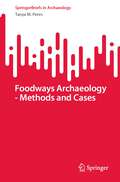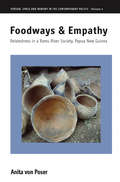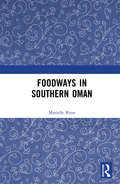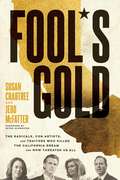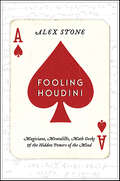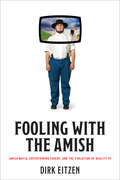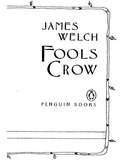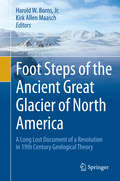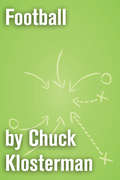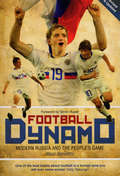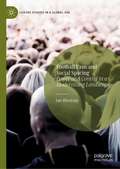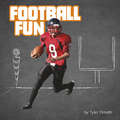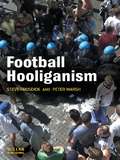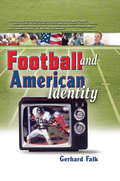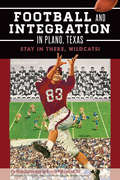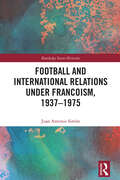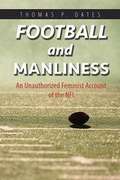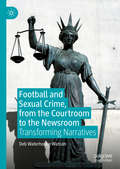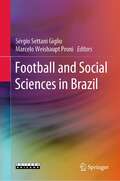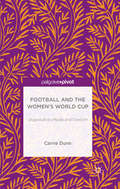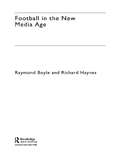- Table View
- List View
Foodways Archaeology - Methods and Cases (SpringerBriefs in Archaeology)
by Tanya M. PeresThis volume presents an overview of methodologies to identify and study foodways in the archaeological record. It also includes definitions, information, and examples for students and professionals to understand the basic analytical approaches, methods, and themes critical to archaeological studies of foodways. One of the main goals of this book is to show that foodways can help us better understand many aspects of a culture and can be studied from the material culture recovered from archaeological sites. It is important to stress that foodways are, and should be, studied by more than zooarchaeologists and paleoethnobotanists. Foodways encompass the biological and cultural need for sustenance, and thus are a research area that incorporates a multitude of artifact types, analytical specialties, and research questions.Foodways are a tangled web of ideas and behaviors that structure diet, subsistence strategies, cuisines, and the use of food to express identity. While foodstuffs are primary components to foodways, the consumption of material foods is inherently social. Food, dishes, and cuisines are expressions of the people, culture, and time in which they are created. Foodways Archaeology is devoted specifically to the archaeological study of the intersection of food, culture, history, and traditions as viewed in the archaeological record.
Foodways and Empathy: Relatedness in a Ramu River Society, Papua New Guinea
by Anita Von PoserThrough the sharing of food, people feel entitled to inquire into one another's lives and ponder one another's states in relation to their foodways. This in-depth study focuses on the Bosmun of Daiden, a Ramu River people in an under-represented area in the ethnography of Papua New Guinea, uncovering the conceptual convergence of local notions of relatedness, foodways, and empathy. In weaving together discussions about paramount values as passed on through myth, the expression of feelings in daily life, and the bodily experience of social and physical environs, a life-world unfolds in which moral, emotional, and embodied foodways contribute notably to the creation of relationships. Concerned with unique processes of "making kin," the book adds a distinct case to recent debates about relatedness and empathy and sheds new light onto the conventional anthropological themes of food production, sharing, and exchange.
Foodways in Southern Oman
by Marielle RisseFoodways in Southern Oman examines the objects, practices and beliefs relating to producing, obtaining, cooking, eating and disposing of food in the Dhofar region of southern Oman. The chapters consider food preparation, who makes what kind of food, and how and when meals are eaten. Marielle Risse connects what is consumed to themes such as land usage, gender, age, purity, privacy and generosity. She also discusses how foodways are related to issues of morality, safety, religion, and tourism. The volume is a result of fourteen years of collecting data and insights in Dhofar, covering topics such as catching fish, herding camels, growing fruits, designing kitchens, cooking meals and setting leftovers out for animals. It will be of interest to scholars from a range of disciplines, including anthropology, sociology, food studies, Middle Eastern studies and Islamic studies.
Fool Proof: How Fear of Playing the Sucker Shapes Our Selves and the Social Order—and What We Can Do About It
by Tess Wilkinson-RyanThe fear of playing the fool is a universal psychological phenomenon and an underappreciated driver of human behavior; in the spirit of Malcolm Gladwell’s Blink, Dan Ariely’s Predictably Irrational, and Susan Cain’s Quiet, Fool Proof tracks the implications of the sucker construct from personal choices to cultural conflict, ultimately charting an unexpected and empowering path forward.In the American moral vernacular, we have a whole thesaurus for victims of exploitation. They are suckers (born every minute), fools (not suffered gladly), dupes, marks, chumps, pawns, and losers. Fool me once, shame on you; fool me twice, shame on me. Cultural stories about suckers abound too: the Trojan Horse, the Boy Who Cried Wolf, the Emperor’s New Clothes, even Hansel and Gretel. If you believe that, I have a bridge to sell you. Don’t go out with him; he only wants one thing. The fear of playing the fool is not just a descriptive fact; it is a prescriptive theme: Don’t let that be you. Most of us are constantly navigating two sets of imperatives: how to be successful and how to be good. The fear of being suckered whispers that you can’t do both, operating as a quiet caution against leaps of faith and acts of altruism. University of Pennsylvania law professor and moral psychologist Tess Wilkinson-Ryan brings evidence from studies in psychology, sociology, and economics to show how the sucker construct shapes, and distorts, human decision-making. Fool Proof offers the first in-depth analysis of the sucker’s game as implicit worldview, drawing evidence everywhere from grocery shopping to international trade deals, from road rage to #MeToo. Offering real-world puzzles and stories, Wilkinson-Ryan explores what kinds of hustles feel like scams and which ones feel like business as usual, who gets pegged as suckers and who gets lauded as saints. She takes deep dives into areas like the psychology of stereotyping, the history of ethnic slurs, and the economics of the family—and shows how the threat of being suckered is deployed to perpetuate social and economic hierarchies. Ultimately, Fool Proof argues that the goal is not so much to spot the con as to renegotiate its meaning. The fear of being suckered can be weaponized to disrupt cooperation and trust, but it can also be defused and reframed to make space for moral agency and social progress. Facing the fear of being suckered head-on means deciding for ourselves what risks to take, what relationships to invest in, when to share, and when to protest—drafting a new template for how to live with integrity in a sucker’s world.
Fool's Gold: The Radicals, Con Artists, and Traitors Who Killed the California Dream and Now Threaten Us All
by Susan Crabtree Jedd McFatterAn investigation that shows how the most ambitious figures in the Democratic Party want to transform the rest of America into the progressive dystopia that is California. Take a close look at today&’s Democratic Party power brokers and you&’ll quickly realize most of them share one thing in common: California. Residents are fleeing the Golden State in droves. Catastrophic wildfires—fueled by years of corruption and collusion between elected officials and colossal utility companies—continue to devastate communities. The state's homelessness crisis is the worst in the country. Drug-related deaths are skyrocketing. And violent crime and smash-and-grab retail theft is now commonplace. For too many across the state, pursuing the Californian Dream is now a fool&’s errand. But what people don't know is what&’s driving these failures, why California&’s leaders have allowed them to spiral and how this contagion could spread to every other city and town in the United States if it isn&’t exposed for what it is: failed far-left social experiments. From the investigative research team behind Peter Schweizer&’s runaway bestsellers comes Fool&’s Gold, a hard-hitting work of journalism that tells the untold story of the dark side of the Democratic Party&’s Californian elites and the toll they&’ve taken on the entire country. One of Schweizer&’s top investigators, Jedd McFatter, has teamed up with award-winning investigative journalist Susan Crabtree to expose the most powerful names in politics: Gavin Newsom, Kamala Harris, Nancy Pelosi, and Adam Schiff, among others. Their investigation exposes: • The most powerful and ambitious politicians and family dynasties and their questionable association with convicted criminals and unsavory business partners. • World-class con artists and their schemes to defraud, plunder, and literally poison the people and institutions of America—including the illegal alien drug dealers getting rich and avoiding prison and deportation while killing Americans with fentanyl and other illicit drugs. • Myriad schemes in which officials line their own pockets and sell out to the Chinese government, along with other foreign interests. • You&’ll see how California&’s elites retain political power at the national and international scale through secrecy and deception. How did the Golden State become this tarnished? And more importantly, why is California&’s corrosion continuing? This explosive book warns that Gavin Newsom is actually right when he often declares, &“As goes California, so goes the nation.&” America&’s future is inextricably tied to California because of its sheer size and the enormous influence of its political figures who remain dead set on controlling the White House for decades to come—and turning the rest of America into California. It&’s a story the mainstream media would prefer to keep hidden.
Fooling Houdini: Magicians, Mentalists, Math Geeks, and the Hidden Powers of the Mind
by Alex StoneFrom the back rooms of New York City’s age-old magic societies to cutting-edge psychology labs, three-card monte games on Canal Street to glossy Las Vegas casinos, Fooling Houdini recounts Alex Stone’s quest to join the ranks of master magicians.As he navigates this quirky and occasionally hilarious subculture populated by brilliant eccentrics, Stone pulls back the curtain on a community shrouded in secrecy, fueled by obsession and brilliance, and organized around one overriding need: to prove one’s worth by deceiving others.But his journey is more than a tale of tricks, gigs, and geeks. By investing some of the lesser-known corners of psychology, neuroscience, physics, history, and even crime, all through the lens of trickery and illusion, Fooling Houdini arrives at a host of startling revelations about how the mind works--and why, sometimes, it doesn’t.
Fooling with the Amish: Amish Mafia, Entertaining Fakery, and the Evolution of Reality TV (Young Center Books in Anabaptist and Pietist Studies)
by Dirk EitzenUsing Amish Mafia as a window into the interplay between the real and the imagined, this book dissects the peculiar appeals and potential dangers of deception in reality TV and popular entertainment.When Amish Mafia was released in 2012, viewers were fascinated by the stories of this secret group of Amish and Mennonite enforcers who used threats, extortion, and violence to keep members of the Amish community in line—and to line their own pockets. While some of the stories were based loosely on actual events, the group itself was a complete fabrication. Its members were played by ex-Amish and ex-Mennonite young adults acting out scenarios concocted by the show's producers. What is most extraordinary about Amish Mafia is that, even though it was fictional, it was cleverly constructed to appear real. Discovery Channel, which aired it, assiduously maintained that it was real; whole episodes were devoted to proving that it was real; and many viewers (including smart reality TV fans) were fooled into believing it was real. In Fooling with the Amish, Dirk Eitzen examines the fakery in Amish Mafia and how actual viewers of the show responded to it to discover answers to two questions that have long puzzled media scholars: What is it about the so-called reality of reality shows that appeals to and gratifies viewers? How and why are people taken in by falsehoods in the media? Eitzen's ultimate answer to these questions is that, in taking liberties with facts, Amish Mafia works very much like gossip. This helps to explain the workings not just of this and other reality TV shows but also of other forms of media fakery, including fake news.The book winds through numerous fascinating case studies of media fakery, from P. T. Barnum's famous "humbugs" of the nineteenth century to recent TV news scandals. It examines the social and emotional appeals of other forms of entertaining fakery, including professional wrestling and supermarket tabloids. It explains how and why conventions of contrivance evolved in reality TV as well as the ethics of media fakery. And, for readers interested in the Amish, it tells how the ex-Amish "stars" of Amish Mafia got involved in the show and the impact that involvement had on their lives.
Fools Crow
by James WelchThe 25th-anniversary edition of "a novel that in the sweep and inevitability of its events...is a major contribution to Native American literature." (Wallace Stegner)In the Two Medicine Territory of Montana, the Lone Eaters, a small band of Blackfeet Indians, are living their immemorial life. The men hunt and mount the occasional horse-taking raid or war party against the enemy Crow. The women tan the hides, sew the beadwork, and raise the children. But the year is 1870, and the whites are moving into their land. Fools Crow, a young warrior and medicine man, has seen the future and knows that the newcomers will punish resistance with swift retribution. First published to broad acclaim in 1986, Fools Crow is James Welch's stunningly evocative portrait of his people's bygone way of life.For more than seventy years, Penguin has been the leading publisher of classic literature in the English-speaking world. With more than 1,700 titles, Penguin Classics represents a global bookshelf of the best works throughout history and across genres and disciplines. Readers trust the series to provide authoritative texts enhanced by introductions and notes by distinguished scholars and contemporary authors, as well as up-to-date translations by award-winning translators.From the Trade Paperback edition.
Foot Steps of the Ancient Great Glacier of North America
by Jr. Harold W. Borns Kirk Allen MaaschJohn K. DeLaski, M. D. practiced medicine in the Penobscot Bay region of Maine and, in addition, was a naturalist with keen powers of observation. His study of the landscape led to the conclusion that a thick glacier had overtopped the highest hills, flooded all of Penobscot Bay, extended far to the east and west and probably was part of a greater continental glacier. He published these very critical field observations and inferences in numerous articles in local newspapers and magazines, and in the American Journal of Science in 1864. His work put him on the "team" of Benjamin Silliman, James D. Dana and Louis Agassiz as an advocate for glaciation as the regional land shaping force opposed to that of the Biblical Deluge, a major scientific conflict of the day both in North America and Europe. He remained a shadowy player, in the background, but clearly contributed critical observations to the argument through personal interactions with Agassiz and other prominent naturalists. They incorporated DeLaski's observations into their own presentations, often without giving him credit. John DeLaski's summary work, a 400 page handwritten manuscript for the book, "The Ancient Great Glacier of North America", was dated 1869. He died in 1874 and the book was not published. The historic significance of DeLaski's unpublished book is based upon its startling contribution to one of the major scientific questions of the day of whether the surficial geology of northern U. S. and Canada was caused by the actions of the Biblical Flood or by continental glaciation. If published, this would have been the first book on this continent, at least, to present a holistic discussion of the controversy in which he presented his critical observations of the surficial geology in Maine, southern New England and New Brunswick, Canada and concluded that these depositional and erosional features must be of glacial origin. DeLaski then incorporated other evidence into the book for glaciation reported by others from the region during a decade or two, and from the mid and far west and Canada to advocate that the entire region was covered by an ice sheet that was at least 5,000 feet and probably much thicker over interior northern U. S. and Canada and which terminated along a glacial margin which extended from southern new England as far westward along the courses of the Ohio, and Missouri Rivers. All this was done while most "naturalists" still advocated the Biblical Flood to explain the major components of the surficial geology in North America and abroad. DeLaski's book containing his critical observations of clearly so many landscape features of glacial origin, if published would have been a pivotal document that would have strongly supported those arguing for glaciations in the glaciations vs. flood international argument.
Football
by Chuck KlostermanOriginally collected in Eating the Dinosaur and now available both as a stand-alone essay and in the collection Chuck Klosterman on Sports, this essay is about football.
Football Dynamo: Modern Russia and the People's Game
by Marc BennettsIn 1991, the collapse of the USSR seemed to signal the death of the Russian football industry, as the money, the players and the fans left. But now the oligarchs who profited from the post-Soviet turmoil are supporting the nation's football clubs and their dreams of glory, resulting in unprecedented success. Along this journey into the heart of Russian football, Marc Bennetts meets the managers, oligarchs, players, pundits and fans that define the Russian Premier league, now the fastest-growing and most intriguing football league in the world. From Andrei Arshavin and the national team's adventures at Euro 2008 to the symbolism of a club from war-torn Chechnya lifting the Russian FA Cup, Football Dynamo uncovers shocking revelations about corruption, hooliganism and racism, but also the true beauty of the game and the country.
Football Fans and Social Spacing: Power and Control in a Modernising Landscape (Leisure Studies in a Global Era)
by Ian WoolseyThis book is about the relationship between leisure and power. More specifically, it theorizes a group of supporters’ attempts to control social space within and around English football stadiums. Not only is football a popular leisure form, it is also one which has undergone a remarkable process of transformation during the last 30 years. Advance surveillance techniques, all seater-stadia, rising ticket prices, and a growing intolerance to expressive modes of fandom have all transformed the experience of watching the professional game.Through these five chapters, Ian Woolsey asks how the collective responses of travelling football supporters to these major societal currents and changes within the game; liquid modernity and the post-1989 transformation of English football, are managed via the distinct and oft-competing processes of social spacing in football. An important inspiration for the book is the work of Zygmunt Bauman, particularly his ideas on cognitive, aesthetic, and moral ‘spacings’ as a social production. Ian Woolsey’s powerful and persuasive application of these ideas not only extends Bauman’s focus on the ‘politics’ of power in public space to include a consideration of leisure but in so doing shows that ethnography, selectively conducted and theoretically informed, can provide data for a rich, sociological account of a football world. The book will be of interest to researchers and scholars of sociology of leisure, sociology of sport, criminology, and cultural studies.
Football Fun (Sports Fun)
by Tyler OmothFootball is fun watch, but even more fun to play! Kids can get in the game by learning about the rules of the sport, the equipment needed to play, and the importance of good sportsmanship. Then they can practice a key football skill to have even more fun on the field.
Football Hooliganism
by Peter Marsh Steve FrosdickThis book provides a highly readable introduction to the phenomenon of football hooliganism, ideal for students taking courses around this subject as well as those having a professional interest in the subject, such as the police and those responsible for stadium safety and management. For anybody else wanting to learn more about one of society's most intractable problems, this book is the place to start. Unlike other books on this subject it is not wedded to a single theoretical perspective but is concerned rather to provide a critical overview of football hooliganism, discussing the various approaches to the subject. Three fallacies provide themes which run through the book: the notion that football hooliganism is new; that it is a uniquely football problem; and that it is predominantly an English phenomenon. The book examines the history of football-related violence, the problems in defining the nature of football hooliganism, the data available on the extent of football hooliganism, provides a detailed review of the various theories about who hooligans are and why they behave as they do, and an analysis of policing and social policy in relation to tackling football hooliganism.
Football Sissy: A Cross-Dressing Memoir
by Jack Brennan"Jack's sports reporting was always fair, honest, and straightforward. He tells his own story in the same exact way." —Cris Collinsworth, NBC Sunday Night Football In Jack Brennan’s decades-long career as a sports journalist, he covered teams like the MLB’s Reds and the NFL’s Cincinnati Bengals. As the public relations director for the Bengals, he wrangled sports stories, reporters, and players. At home, he played basketball with the neighborhood husbands and raised three kids with his wife, to whom he was devoted. At the same time, he had a passion that never left him: he liked dressing as a woman. Blonde silky hair, bright lips, and smooth legs escaping short skirts, topped off with heels as high as they go. He kept his life as a crossdresser mostly private, so his public coming out via The Athletic in 2021—one of the first men in the NFL to come out as LGBTQ+—was a surprise to many. Football Sissy offers a no-holds-barred trip through his dual lives, from his earliest love affair with a puff-sleeve blouse at age three through to his first jaunts dressed in public to surprise visits to the hospital alongside a fulfilling family life and an exciting career. Told with the characteristic humor and ease of Brennan’s sports columns, Football Sissy is a heartwarming tale of acceptance and love, even within the most masculine of environments.
Football and Accelerated Culture: This Modern Sporting Life (Routledge Research in Sport, Culture and Society)
by Steve RedheadIn Football and Accelerated Culture, Steve Redhead offers a new and challenging theorisation of global football culture, exploring the relationship between sport and culture in a rapidly shifting world. Incorporating cutting-edge concepts, from accelerated culture and claustropolitanism to non-postmodernity, he reflects on the demise of working class football cultures and the rapid media globalisation of ‘the people’s game’. Drawing on international empirical research and a unique and ground-breaking study of football hooligan memoirs, the book delves into a wide array of disciplines, examining fascinating topics such as the relationship between music and football; hooligans and ultras; the rise of social media and anti-modern football movements; and ultra-realist criminology. Football and Accelerated Culture offers a new way of thinking about sporting cultures that expands the boundaries of physical cultural studies. As such, it is important reading for anybody with an interest in the culture of sport and leisure, social theory, communication studies, criminology or socio-legal studies.
Football and American Identity (Contemporary Sports Issues Ser.)
by Frank Hoffmann Martin J Manning Gerhard FalkLearn the value of football to American societyNo sport reflects the American value system like football. Visitors to the United States need only watch a game or two to learn all they need to know about the American way of life and the beliefs, attitudes, and concerns of American society. Football and American Identity examines the social conditions and cultural implications found in the football subculture, represented by core values such as competition, conflict, diversity, power, economic success, fair play, liberty, and patriotism. This unique book goes beyond the standard fare on football strategy and history, or the biographies of famous players and coaches, to analyze the reasons why the game is the essence of the American spirit. Author Gerhard Falk, Professor of Sociology at the State University College of New York at Buffalo, examines football as a game, as a business, and as a reflection of the diversity in American life. Football and American Identity also addresses the relationship between football and the media, with much of the game&’s income generated by advertising and endorsements, and examines the presence of crime in football culture. The book discusses the development of the game-and those involved in it-at the Pop Warner, college, and professional levels, examining the social origin of players, coaches, cheerleaders, and owners. In addition, Football and American Identity analyzes the game&’s fans and their devotion to "their" teams, examines why Pennsylvania is considered the "mother" of American football, and looks at the National Football League and its commissioners. Football and American Identity examines: how individualism and achievement can lead to mythological status why a person&’s occupation is the most important indicator of prestige in the United States what the consequences are of earning more in a year than most Americans make in a lifetime why equality is vital to the ethnic make-up of American football teams why teamwork is important-in football and in industry how freedom is essential for taking the risks necessary for success and much more!Football and American Identity is an inside look at football as an American cultural phenomenon. Devoted and casual fans of the game, as well as academics working in sociology, will find this unique book interesting, entertaining, and thought-provoking.
Football and Health Improvement: an Emergent Field (Sport in the Global Society – Contemporary Perspectives)
by Daniel Parnell Andy PringleThere is developing interest in the use of sporting settings as a channel to connect people to health improvement services and an emerging body of research highlights football as being associated with positive motivational and social elements that support the maintenance of a physically active lifestyle. This text provides insights into a range of issues surrounding the role of football as a vehicle for health improvement for different groups.The contributors to this volume share some of the challenges and the benefits of using professional football settings as a channel for connecting people to health improvement opportunities. These chapters will be of interest to a range of stakeholders involved in research, policy and practice who stand to benefit from building partnerships with colleagues with expertise in (I) conducting evaluation and (II) reporting evaluation and research outcomes in peer-reviewed mediums, reflecting the value of partnerships between football-led health improvement and evaluators. This book was previously published as a special issue of Soccer & Society.
Football and Integration in Plano, Texas: Stay in there, Wildcats! (Sports)
by Inc. Robert Haynes Billy Ray Smith The Plano Conservancy for Historic PreservationThe year 1964 was momentous for civil rights as Congress passed the Twenty-fourth Amendment and Texas's own Lyndon B. Johnson unveiled his plan for the Great Society. That same year, the Plano school district integrated, setting an example for the state and nation. The tightknit community banded together through a language fluent to everyone--football. The Wildcats had few winning seasons and no state titles at that time, but with hard work and a trailblazing spirit, coaches Tom Gray and John Clark led the integrated team all the way to state championship victory in 1965. The Plano Conservancy for Historic Preservation, Inc. presents the inspiring story of the Wildcat fight for the title that made Plano a better place to live.
Football and International Relations under Francoism, 1937–1975 (Routledge Soccer Histories)
by Juan Antonio SimónThis book shines a light on the specific role football played in relation to the international relations of the Franco regime in mid-twentieth-century Spain.In the 35 years of the dictatorship of General Francisco Franco, sport, specifically football as the main mass sport, was often used as a tool at the service of the political and diplomatic interests of the regime, and this volume analyses how Franco's government, mainly through its Ministry of Foreign Affairs, used football as part of its foreign policy strategy to promote the international image of the dictatorship. Prestige international tours and friendly matches, the European successes of Real Madrid CF and of the national team and the organisation of sporting events such as the 1964 European Nations Cup were used as instruments to strengthen the country's geopolitical interests. This book responds to an important bibliographical gap that exists in relation to both research on Franco's regime and the study of the role that sport played under Franco and in comparison with other totalitarian regimes such as fascism and Nazism.Football and International Relations under Francoism, 1937–1975 is an ideal resource for academics in sports history, football history and international relations studies, as well as those with an interest in Spanish history and the study of totalitarianism in Europe.
Football and Manliness: An Unauthorized Feminist Account of the NFL
by Thomas P. OatesWomen, African Americans, and gays have recently upended US culture with demands for inclusion and respect, while economic changes have transformed work and daily life for millions of Americans. The national obsession with the National Football League provides a window on this dynamic period of change, reshaping ideas about manliness to respond to new urgencies on and beyond the gridiron. Thomas P. Oates uses feminist theory to break down the dynamic cultural politics shaping, and shaped by, today's NFL. As he shows, the league's wildly popular product provides an arena for media producers to work out and recalibrate the anxieties, contradictions, and challenges that characterize contemporary masculinity. Oates draws from a range of pop culture narratives to map the complex set of theories about gender and race and to reveal a league and fan base in flux. Though longing for a past dominated by white masculinity, the mediated NFL also subtly aligns with a new economic reality that demands it cope with the shifting relations of gender, race, sexuality, and class. Indeed, pro football crafts new meanings of each by its canny mobilization of historic ideological processes.
Football and Sexual Crime, from the Courtroom to the Newsroom: Transforming Narratives
by Deb Waterhouse-WatsonThis book interrogates the process of court reporting on rape and other sexual crime cases involving Australian footballers. At the intersection of sport, gender, media and the law, it uncovers the story behind rape myths and stereotypes in media. This book analyses newspaper reporting alongside transcripts of the trials they represent and interviews with the journalists themselves. Waterhouse-Watson’s work maps structural factors within newsrooms, and the complex relationship between the judiciary and media, that affect the practice of court reporting. This book approaches key journalism concepts like objectivity and balance critically, illustrating the layers of mediation that surround a complainant’s testimony; the way sport shapes the meaning of courtroom and media narratives in these cases; and the tension between racism and sexism when race is thematised or otherwise highlighted. Ultimately, the book proposes an ethics of court reporting that protects individual complainants, as well as advancing public understandings of the crime.
Football and Social Sciences in Brazil
by Sérgio Settani Giglio Marcelo Weishaupt ProniThis book presents a kaleidoscopic view of the multidisciplinary field of research developed within Brazilian social sciences to study football as a major cultural and social phenomenon in the country. As a contributed volume, it brings together chapters authored by researchers from different disciplines, such as sociology, anthropology, political science, history, geography, economy, communication studies and physical education, who contributed to make Brazilian football a multifaceted object of study for the human and social sciences. The book is divided in four parts. The first two parts are dedicated to the "classic" areas, in which the best known research lines are concentrated: part one focuses on politics and history, while part two is dedicated to sociology and anthropology. The third part brings together studies from other four different areas: communication studies, geography, economy and physical education. The fourth part is organized not by disciplines, but around transversal themes, such as gender, violence, fans and racism. The varied approaches and different interpretations brought together in this book seek to provide an overview of the fertile academic debate that has stimulated the renewal of scientific research on football in Brazil, which makes Football and Social Sciences in Brazil a useful resource for researchers from different disciplines within the human and social sciences interested in the study of football as major cultural and social phenomenon all over the world.
Football and the Women's World Cup: Organisation, Media and Fandom
by Carrie DunnWomen's football is the fastest growing participation sport in both the UK and across the world, and the 2015 Women's World Cup was the biggest tournament the sport had ever seen. This book explores the experience of fans of women's football who followed their teams in Canada, examining their practices and fan behaviour. How did host cities manage the influx of visitors? And how did fans manage to support their teams, considering the vast amounts of travel expected across such a big country? Dunn also examines the way that the England team is structured and run, relating this to the country's domestic competition, as well as assessing the media coverage of women's football globally. This research is all framed within the author's own experiences of the Women's World Cup, as both an academic and as a sports journalist.
Football in the New Media Age
by Richard Haynes Raymond BoyleFootball in the New Media Age analyzes the impact of media change on the football industry, drawing on extensive interviews with key people in the media and football industry. It examines the finances of the game; the rising importance of rights and rights management in the industry; and attempts by clubs to develop their own media capacity. At the core of the book is an examination of the battle for control of the game as media, business and fans all seek to redefine the sport in the twenty-first century. Football is rarely out of the headlines, with stories about star players misbehaving, clubs facing financial meltdown, or TV companies battling over broadcast rights dominating much of the mainstream news and current affairs agenda.The impact of the vast amounts of money paid to elite footballers, and the inability of young men to cope with this when combined with their media-fuelled celebrity status, have frequently made headlines. At the core of this process is the battle to control a game that has exploited its position as a key 'content provider' for new media over the last decade, and this book provides the examiniation and analysis to study this problem.
